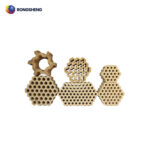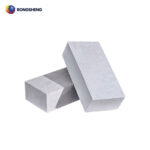Solutions for Mullite Lightweight Insulation Bricks
Lightweight mullite insulation bricks, with their excellent thermal insulation properties, effectively reduce heat loss and contribute to energy savings in the insulation layer. They also perform well in the less corrosive working layer of the furnace lining, the area in direct contact with the flame. For example, JM23, 26, 28, 30, and 32 bricks can be used in neutral furnace lining environments with direct flame contact. JM30 and 32 bricks, like hollow alumina sphere bricks, are particularly suitable for high-temperature applications. Not only do they provide excellent insulation, their light weight also makes them particularly effective in lightweight kilns.

Lightweight Mullite Insulation Bricks: An Excellent Solution
Weight Issues with Traditional Refractory Materials
Traditional heavy refractory bricks place a heavy burden on equipment, increasing load-bearing requirements and potentially causing structural deformation or even damage. For example, in the export process of ceramic kilns, using heavy refractory bricks would make the furnace structure thicker and heavier, increasing the unit weight of the segmented kiln, exceeding the container’s load limit, making transportation and installation extremely inconvenient. Lightweight mullite insulation bricks, however, easily solve this problem and can be flexibly applied to equipment of various structures. Even heavy equipment with high load-bearing requirements can achieve better performance due to their light weight and high compressive strength.
Energy Waste Caused by Poor Insulation
Some traditional refractory materials have poor insulation, resulting in significant heat loss. This results in significant energy losses and financial costs for businesses. For example, in ceramic firing, if the insulation material is poor, heat within the kiln will dissipate rapidly. To ensure firing quality, constant heat replenishment is required, increasing fuel consumption. Mullite lightweight insulation bricks, with their excellent thermal insulation properties, can effectively prevent heat loss, reduce energy waste, and save considerable costs for enterprises.
Reliability Issues of Thermal Insulation Materials at High Temperatures
Under high-temperature environments, many traditional refractory materials experience performance degradation, such as cracking, flaking, and shrinkage. This not only affects insulation effectiveness but can also cause further damage to kiln equipment. However, the high-temperature stability of mullite lightweight insulation bricks ensures their reliability at high temperatures, preventing these issues from occurring with rising temperatures. This ensures long-term stable operation of equipment and reduces repair costs and downtime caused by material failure.
With their lightweight, excellent insulation performance, and high-temperature stability, mullite lightweight insulation bricks perfectly address the weight, insulation effectiveness, and high-temperature reliability challenges of traditional refractory materials, making them an indispensable and ideal choice for customers seeking high-temperature insulation materials.

JM30 Lightweight Mullite Insulation Brick
JM30 lightweight mullite insulation brick is a high-performance refractory material with mullite as the primary crystalline phase. It has an alumina content of ≥70%, a refractoriness exceeding 1600°C, and a softening temperature under load of ≥1470°C. Its bulk density is ≤1.05g/cm³, and its compressive strength at room temperature is ≥3.5MPa. It combines low thermal conductivity (≤0.46 W/(m·K) at 600°C) with excellent thermal shock resistance, significantly reducing heat loss and extending kiln life. Custom sizes and shapes are available. Suitable for lining shuttle kilns, roller hearth kilns, glass melting furnaces, and high-temperature petrochemical equipment, meeting energy-saving and high-efficiency requirements.
Optimizing the Application of Mullite Polymer Bricks
The Versatile Applications of Mullite Polymer Bricks: Mullite polymer bricks are a high-performance refractory material with a wide range of applications.
Application Limitations of Polymer Bricks in Different Furnace Lining Environments
However, polymer bricks are not suitable for all furnace lining environments. In the working layer of a furnace lining exposed to strong acids and alkalis, polymer bricks lack strength and are easily eroded by the aggressive slag, making them unsuitable for use. In contrast, hollow alumina sphere bricks can still function normally in such environments.
Recommendations for the Suitable Selection of Mullite Polymer Bricks
Based on current market usage, mullite polymer bricks are primarily used for insulation. When the external furnace shell temperature requirement is low and the temperature and environmental conditions are suitable, mullite polymer bricks can be used. When using a multi-layer masonry system, JM23 bricks can be used near the furnace shell, while JM28, 30, or 32 bricks can be used in areas exposed to the flame. This layered selection method can give full play to the advantages of mullite lightweight bricks, meet the usage needs of different areas, and achieve the dual effects of thermal insulation and fire resistance.





